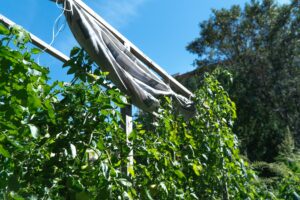Lea una versión en español.
From tomatoes and eggplants to corn and callaloo, the Rainbow Garden of Life and Health on Melrose Avenue seemed to have it all figured out when it came to urban gardening.
This summer, however, changing weather patterns affected plant growth and established practices, forcing members of the 11,000-square-foot pocket park to improvise.
Angel Garcia, a board member for the park, said they introduced a new rule this year discouraging members from visiting when daytime temperatures reached 90 degrees.
High-temperature days this summer had extended into “waves” that sometimes lasted an entire week, Garcia said. “We didn’t have that last year.”
The National Weather Service recorded 21 days between June and August with maximum temperatures reaching at least 90, nearly four times the number of days recorded within the same period the previous year and a decade ago.
Excessive heat causes plants to lose water quickly, impacting their growth.

In La Finca del Sur on East 138th Street, the heat also caused gardeners to miss days.
“If your gardeners are not coming as regularly as you’d like, then crops can become overgrown and basically are just good for composting,” said Nancy Ortiz-Surun, La Finca’s co-founder.
The heat made them think about planting drought-resistant crops like collard greens, Swiss chard, and kale, she said.
But there was another problem: an uptick in insects.

With fewer active gardeners, mosquitoes increased due to the overgrowth of weeds, Ortiz-Surun said.
Heavier rain and wind gusts also erode and loosen the soil, uprooting plants. This happened to Garcia’s sunflowers at Rainbow Garden.
The Weather Service recorded four days with at least 1.4 inches of precipitation this summer, compared with none last year.
Crops and food insecurity
While tomatoes usually ripen in August, this year many remained unripe in mid-September.
To combat the heat, Javier Marchand, a board member at Rainbow Garden, installed a curtain to block the harsh afternoon sun.
While his tomatoes had grown to eight feet, they were mostly still green.
“When it’s too hot, tomatoes won’t develop as many flowers,” Marchand said. “No flowers, no tomatoes.”
Marchand, who is also a home cook, uses most of the vegetables he grows for his dishes. Another La Finca member brings vegetables from the garden to the restaurant she used to operate.
Community gardens also serve a vital need for food-insecure New Yorkers, said Qiana Mickie, executive director of the Mayor’s Office of Urban Agriculture.
In 2022, one in four residents in Melrose and Mott Haven were food insecure, according to the New York City Food Policy Center at Hunter College, compared with 15.4% citywide.
“The South Bronx has some of the most vibrant community gardens and places where folks are growing food, whether they’re doing it individually for themselves and their families, or scaling into farms,” said Mickie.
Twenty-four acres of land in the Bronx are used for gardens, according to the Parks Department.
The New York Botanical Garden said its Bronx Community Farm Hubs network grew and distributed more than 77,000 pounds of food between 2020 and 2023.
La Finca said they produced up to 700 pounds of crops last year.
Resiliency
La Finca is one of three hubs where Melrose community group Nos Quedamos is building solar-powered resiliency hubs, designed to provide shelter, water, and power during climate emergencies.
“It’s not just about sheltering from the weather but also having a space to receive accurate and timely communication on emergencies and how to respond,” said Basil Alsubee, a program manager at Nos Quedamos.

Community gardens are facing “increasing water irrigation demands” due to droughts and heatwaves, said Judd Faulkner, a press officer for NYC Parks.
To address this, some gardens built rainwater harvesting systems that help irrigate crops. Others, like Rainbow Garden, still relied on manually filling buckets at nearby fire hydrants.
But an irrigation system directly connected to the city’s water system is currently underway at Rainbow Garden. While the project is still in the works, Garcia invited a different ally to the garden: pollinators.
“I deliberately looked up what are good plants for pollinators,” he said. “And so, marigolds.”
Pollinators, like bees and birds, do not only serve Garcia’s marigolds. Tomatoes, eggplants, and even basil and mint have flowers that benefit from them.
Bees, in particular, are facing significant threats due to colony collapse disorder, a phenomenon where entire bee colonies vanish. This may be linked to changes in habitat, pesticide poisoning, or inadequate forage, according to the Environmental Protection Agency.
NYBG’s Bronx Green-up said it has partnered with several organizations to distribute native plants that help increase pollinator habitat.
“Pollinators play a crucial role in the ecology of the city, pollinating many of our food crops and other flowering plants, supporting plant and wildlife biodiversity,” said Ursula Chanse, senior director of Bronx Green‑Up and Community Horticulture. “Their role is ever more important in the context of climate impacts.”
This was the first time there were that many bees in Rainbow Garden, Garcia said.

